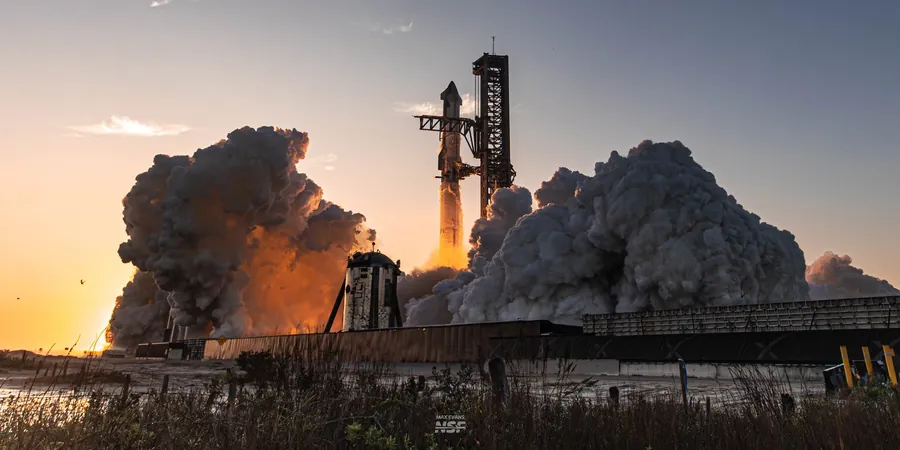
Groundbreaking Study Unveils the Sonic Power of SpaceX's Starship: A Comparative Analysis with SLS and Falcon 9
2024-11-18
Author: Kai
Groundbreaking Study Unveils the Sonic Power of SpaceX's Starship: A Comparative Analysis with SLS and Falcon 9
In a remarkable revelation, a team of scientists from Brigham Young University (BYU) has conducted a comprehensive study on the audibility levels generated from SpaceX's Starship and Super Heavy rocket during their historic launches. This monumental rocket, launching at the powerful force of 74.4 meganewtons from its 33 Raptor engines, has raised serious discussions regarding the potential environmental consequences of its thrice-fold louder launch cadence compared to its predecessors, NASA's Space Launch System (SLS) and SpaceX's Falcon 9.
As SpaceX gears up for what could be Starship's sixth flight test soon, their aspirations to achieve a rapid launch schedule in 2025 are palpable. Understanding the environmental impacts and the sonic booms produced during liftoff is crucial, especially when considering that SpaceX aims to launch Starship up to hundreds of times in a single year.
To grasp the true soundscape of this spectacular launch vehicle, researchers led by Kent Gee deployed eight monitoring sites near SpaceX's Starbase in Boca Chica, Texas, during Starship’s fifth flight test. The noise data they collected was compared against the Federal Aviation Administration’s (FAA) Environmental Assessment (EA) predictions to analyze discrepancies in the auditory impact.
Notably, these measurements uncovered significant differences: the sound levels at takeoff surpassed prior estimations, revealing a stark contrast to what had been anticipated. The study revealed that a single launch of Starship can produce noise equivalent to at least 10 launches of the Falcon 9 and remarkably overshot SLS launch sound levels as well. It appears that despite SLS's thrust capacity, Starship’s unique engine configuration contributes to its unparalleled noise levels, with the sonic booms from Super Heavy being 50% louder than those produced by the renowned Concorde supersonic aircraft.
The scientists assessed various data metrics, including A-weighting and Z-weighting—two methodologies that illustrate sound levels perceived by the human ear versus actual sound levels. Their findings highlighted that at 20 km from the launch site, the sonic boom of Super Heavy reached approximately 110 decibels, which significantly overshot the EA's estimations, raising alarms about the implications for communities surrounding launch zones.
Strikingly, while Super Heavy's landing is engineered to be less aggressive, the data indicated that its sonic impact matches that of its liftoff—an unexpected but critical insight that requires further investigation into the intricacies of sound production during these high-stakes events. Local disturbances were even noted, with car alarms triggered by a sonic boom at certain distances but not at others, underscoring the unpredictable nature of sonic events.
In conclusion, the BYU team's research serves as a foundational step in understanding the acoustic effects of SpaceX’s ambitious plans for Starship, which continuously push the boundaries of rocket technology and operational frequency. Their findings not only pave the way for future assessments of noise pollution related to space launches but also hold immense implications for advancing engineering designs in aerospace technology. With upcoming Flight 6 and further data collection, BYU scientists are set to deepen our understanding of the sound profiles involved, aiming to ensure that the world’s most powerful—and noisiest—rocket operates with consideration of its environmental footprint.
Stay tuned as SpaceX pushes the envelope of space travel with possibly hundreds of launches per year, all while striving to mitigate the impact of this record-breaking sound on local communities.



 Brasil (PT)
Brasil (PT)
 Canada (EN)
Canada (EN)
 Chile (ES)
Chile (ES)
 España (ES)
España (ES)
 France (FR)
France (FR)
 Hong Kong (EN)
Hong Kong (EN)
 Italia (IT)
Italia (IT)
 日本 (JA)
日本 (JA)
 Magyarország (HU)
Magyarország (HU)
 Norge (NO)
Norge (NO)
 Polska (PL)
Polska (PL)
 Schweiz (DE)
Schweiz (DE)
 Singapore (EN)
Singapore (EN)
 Sverige (SV)
Sverige (SV)
 Suomi (FI)
Suomi (FI)
 Türkiye (TR)
Türkiye (TR)